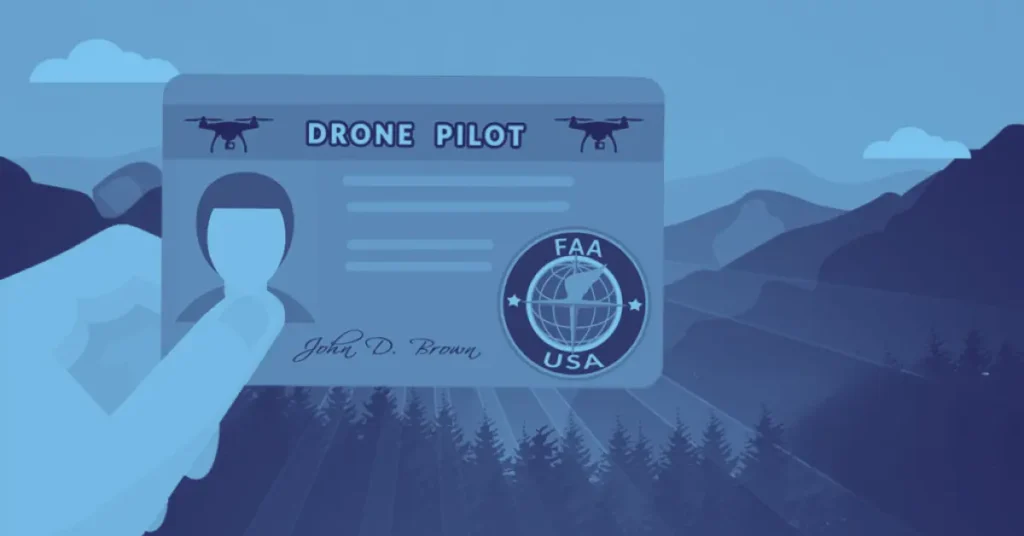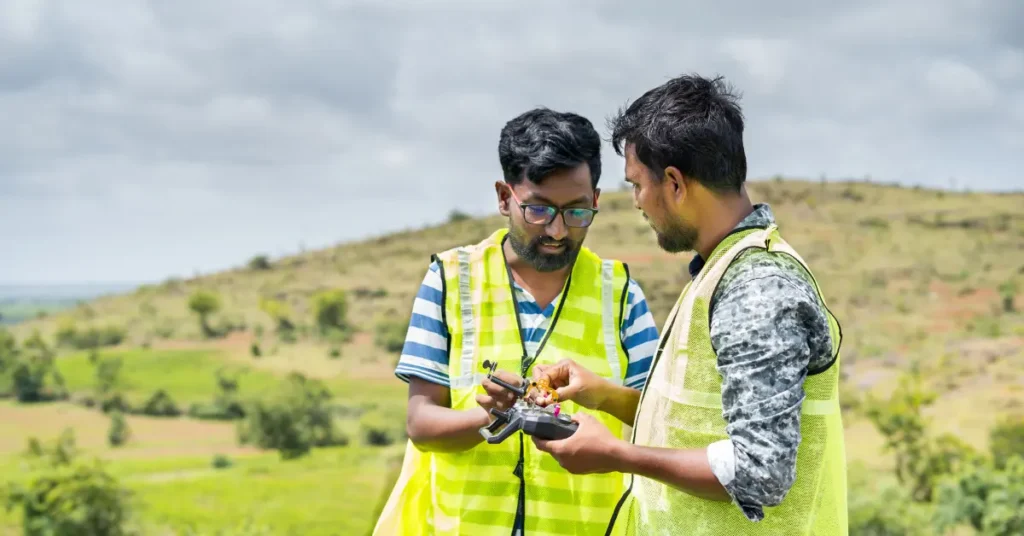Photography, agriculture, and real estate are just a few of the industries that drones have transformed, shaping a high interest in drone piloting careers. Getting a drone pilot license is the initial step in becoming a drone pilot in the United States. In order to ensure safety and compliance, the Federal Aviation Administration (FAA) regulates commercial drone activities. In this article, we will take a look at the FAA requirements, costs, and benefits of drone pilot certification to help you start your career in this booming industry.

What Is a Drone Pilot License?
A drone pilot license, officially known as a Remote Pilot Certificate, is needed to operate drones for commercial purposes in the United States. The FAA mandates that individuals pass a knowledge test under Part 107 of the Federal Aviation Regulations to legally fly drones for business use.
This certification helps drone pilots learn U.S. airspace rules, weather effects, and safety guidelines, making flights safer and more reliable. No matter if you use drones for photography, inspections, or mapping, getting this certification is an important step.
Why Do You Need a Drone Pilot License in the U.S.?
Getting a drone pilot license is important for safety, following FAA rules, and finding job opportunities. Here’s why it matters:
- Legal Compliance: The FAA requires commercial drone pilots to have a license under 14 CFR Part 107 to fly safely and legally.
- Job Opportunities: Having a license helps you find work in areas like filmmaking, surveying, and inspecting infrastructure.
- Improved Skills: Training programs help pilots improve navigation, safety, and emergency response techniques.
- Insurance & Liability Protection: Many insurance companies require proof of FAA certification before covering drone operations.
How to Become a Drone Pilot in the U.S.
To earn your FAA drone pilot certification, follow these steps:
1. Meet the FAA Eligibility Requirements
To qualify for a drone pilot license under Part 107, you must:
- Must be at least 16 years old
- Should be able to write, read, and understand English
- Be in a mental and physical condition to operate a drone safely
2. Pass the FAA Part 107 Knowledge Exam
The Part 107 Remote Pilot Exam is a multiple-choice test administered by FAA-approved Knowledge Testing Centers (KTCs). The exam covers various topics to ensure that drone pilots understand U.S. aviation regulations and safe flight operations. Key areas include:
- Airspace Classification & Restrictions: Understanding controlled and uncontrolled airspace, restricted zones, and temporary flight restrictions.
- Weather Conditions: Learning how weather affects drone flight, including wind patterns and cloud formations.
- Drone Maintenance & Safety Procedures: Covering pre-flight checks, maintenance schedules, and emergency protocols.
- FAA Regulations & Operational Rules: Understanding legal requirements such as maximum altitude limits (400 feet AGL), daylight operation rules, and line-of-sight requirements.
The test/examination consists of 60 multiple-choice questions, and a passing rate is 70% or higher.
Preparing for the FAA Aeronautical Knowledge Test requires understanding complex topics like airspace regulations, weather, and emergency procedures. Many aspiring pilots, especially students or professionals juggling multiple responsibilities, find it helpful to get academic support when compiling reports or technical essays. In such cases, you can pay someone to do my essay to receive expert assistance while focusing on mastering flight operations and exam preparation.
3. Apply for the FAA Remote Pilot Certificate
Once you pass the test, apply through the FAA’s IACRA website. The FAA will review your application and have the TSA do a background check before issuing your drone pilot license.
4. Complete FAA Drone Training (Optional but Recommended)
Training isn’t required, but many future drone pilots take FAA-approved online or in-person courses to prepare for the Part 107 exam. These courses cost between $100 and $300 and cover U.S. drone rules and flight operations.
5. Renew Your FAA License Every Two Years
To maintain your FAA certification, you must complete a free online recurrent training course every two years. This ensures that drone pilots stay updated on evolving FAA regulations and best practices.
Drone Pilot License Cost in the United States
The total cost of obtaining an FAA drone pilot certification includes:
- FAA Part 107 Exam Fee: $175
- Training Courses (Optional): $100-$300 (for online or in-person classes)
- License Renewal (Every Two Years): Free online recurrent test
- Drone Equipment Costs: $500-$3,000+ (varies depending on the drone model and accessories)
Career Opportunities and Commercial Drone Pilot Salary in the U.S.
Earning an FAA drone pilot license opens doors to various career opportunities. The average commercial drone pilot salary in the U.S. ranges from $50,000 to over $150,000 annually, depending on experience and industry demand.
Industries Hiring Drone Pilots in the U.S.
- Aerial Photography & Videography: Media companies hire drone pilots for film production, wedding photography, and commercial advertisements.
- Surveying & Mapping: Drones assist in land surveying, construction site mapping, and urban planning projects.
- Infrastructure Inspection & Monitoring: Industries such as agriculture, energy, and telecommunications use drones for infrastructure inspections.
- Real Estate Marketing: Realtors and property developers use drone footage to showcase properties from aerial perspectives.
- Delivery Services: Companies like Amazon and UPS are testing drone delivery services.
- Search & Rescue Operations: Rescue teams use drones to find missing people and evaluate disaster areas.
How Much Can a Drone Pilot Earn in the U.S.?
- Freelance Drone Pilots: $25 – $200 per hour, depending on expertise and industry demand.
- Full-Time Commercial Drone Operators: $50,000 – $100,000+ annually.
- Specialized Drone Pilots (e.g., Oil & Gas, Mapping, Agriculture): Can earn over $150,000 annually with advanced certifications and experience.

Tips for Success as a Drone Pilot in the United States
1. Invest in High-Quality FAA-Approved Equipment
Choose a drone that meets FAA requirements and suits your career goals. High-end drones with advanced features such as thermal imaging and high-resolution cameras can increase earning potential.
2. Build a Strong Portfolio
If you want to work in aerial photography or videography, build an FAA-compliant portfolio with your best work to attract clients and job opportunities.
3. Network and Market Yourself
Join U.S. drone pilot groups, attend FAA events, and market your services online to grow your network and find clients.
4. Stay Updated on FAA Regulations
The FAA often updates its rules. Stay informed about new guidelines to follow the law and avoid penalties.
5. Obtain Additional FAA-Recognized Certifications
Getting FAA-approved certifications in drone surveying, thermal imaging, or mapping can help you find better job opportunities with higher pay.
Conclusion
A FAA drone pilot license is significant for anyone seeking to enter the commercial drone industry in the United States. With the right training, passing the FAA Part 107 exam, and getting certified, you can turn your love for drones into a well-paying career.
Whether you want to work in aerial photography, inspections, surveying, or delivery services, becoming a certified drone pilot opens doors to exciting opportunities. Take the first step today and explore the growing world of professional drone piloting under FAA regulations!
